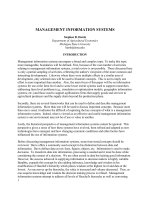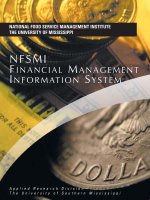Management information system
Bạn đang xem bản rút gọn của tài liệu. Xem và tải ngay bản đầy đủ của tài liệu tại đây (5.26 MB, 69 trang )
Overview of Information
Technology Concepts
Instructor: Prof. Ilyoo B. Hong
Contents
Business environment and IT
Data Vs. information
Roles of IT in business corporations
What is MIS?
Business environment & IT
Innovations
Obscelence
EC
Info. overload
Global
Competitive
Changing workforce
Powerful consumers
Social responsib.
Gov’t regulations
Deregulations
Ethics
Organizations
Information Technology
Technological
Market Society
Data Vs. Information
Data
– raw as collected
– eg) ages or heights of students in class
Information
– extracted from data
– readily useful for decision-making or problem-
solving
– eg) mean or median of students’ ages or heights
Roles of IT in business firms
Improvement of operational efficiency
– automates routine operations
Improvement of responsiveness
– reduces ‘time to market’ by shortening the product
development cycle
– reduces manufacturing costs
Support of supply chain
– improves inventory management
– provides information of strategic value
What is MIS?
the computer and communications
technology that supports business
operations and management of a firm
an integrated, computer-based, interactive
system that provides information to support
operations and decision-making
can collect, process, store, analyze, and
disseminate information for a specific
purpose
Strategic
Planning
Tactical
Control
Operational
Control
Top
Management
Middle
Management
Low-level
Mgmt
Sales/
Mkt.
Mfg.
Financial
Mgmt.
Acct.
Personnel
Mgmt.
Business Functions &
Management Levels
TPS (Transaction Processing Systems): process transaction data
IRS (Information Reporting Systems): provide information for mgmt.
DSS (Decision Supporting Systems): supports mgmt decision making
ES (Expert Systems): solve problems by mimicking experts
EIS (Executive Information Systems): provide info for executives
OAS (Office Automation Systems): support knowledge workers
SIS (Strategic Information Systems): create a competitive edge
GDSS (Group Decision Support Systems): support electronic meetings
How IS Have Evolved
Unit 2. Strategic Use of IT
Instructor: Prof. Ilyoo B. Hong
No. 1
정보기술의
전략적
활용
Contents
● Business Environment and Competitive Strategy
- Competitive forces model as an industry analysis framework
- Generic strategies
- Value chain analysis model
● What is a Strategic Information System(SIS)?
- The SIS concept
- Using IT to create a competitive edge
● SIS and Generic Strategies
- Implementing the cost leadership strategy
- Implementing the differentiation strategy
- Implementing the focus strategy
● SIS and Value Chain Analysis (VCA)
No. 2
정보기술의
전략적
활용
Competitive Forces Model
● Michael Porter proposes the Competitive Forces Model as a tool to analyze
a given industry
● It presumes that a business firm competes with five competitive forces
● If these competitive forces turn out to be strong, then the overall intensity
of the industry is high, and thus, the profit potential for the firm is slim.
● The Competitive Forces Model can be used to weaken one or more
competitive forces.
No. 3
정보기술의
전략적
활용
Competitive Forces Model
● The five competitive forces affect the intensity of competition within an industry
● The more intense the competition, the slimmer the profit potential a firm expects.
Threat of New
Potential Entrant
Threat of Substitute
Products/Services
Bargaining
Power of Buyers
Bargaining Power
of Suppliers
Competition among
Existing Rivals
No. 4
정보기술의
전략적
활용
Traditional Vs. Strategic Information Systems
● Traditional Information Systems
- Focuses on improving operational efficiency
- e.g., transaction processing systems
● Strategic Information systems
- Uses information systems as a competitive weapon, beyond the efficiency focus
- Centers on creating a competitive edge by weakening competitive forces
- Ultimately aims at increasing sales or expanding market shares
No. 5
정보기술의
전략적
활용
Classical SIS Example #1
● American Hospital Supply’s ASAP
- Online order entry and processing system
- Based on the telecomm. network linking AHS with its customers (hospitals)
- Receives an online order directly from the purchasing dept. of a hospital
- Value for customer: streamlining the hospital purchasing process for efficiency
and convenience
- Value for AHS: Speeding the order processing; expanding the market share
No. 6
정보기술의
전략적
활용
Classical SIS Example #2
● United Air’s Apollo
- Computer-based airline reservation system
- Uses leased lines between UA and travel agencies
- A travel agent can use a terminal to access seat reservation and flight
information
- UA manipulated the way travel agents access information such that information
on their flights will be more visible than information on their competitors
- Value for customer: convenient access to reservation and flight information
- Value for UA: increased sales
No. 7
정보기술의
전략적
활용
경쟁사
예약시스템
APOLLO
Tr. agent
Tr. agent
Tr. agent
Tr. agent
Tr. agent
Tr. agent
flight, reservation,
seat layout info.
Competitors’
ARS
United Air’s APOLLO
APOLLO’s role
Limiting information access by competitors
Controlling information access by travel agents
Analyzing routes/fares of competitors
Impacts on firms/industry
Creating a competitive edge for SIS innovator
Causing some competitors to bankrupt
Increasing competition within an industry
No. 8
정보기술의
전략적
활용
Using IT to create a competitive advantage
● Creating switching costs
- Weakens the bargaining power of buyers
- e.g., branchless virtual bank in France (Bank customers get locked in)
● Shift in balance of power via information monitoring
- Weakens the bargaining power of suppliers
- e.g., the dept. store that uses a computer network to monitor prices and stock levels and make
purchase decisions
● Building entry barriers
- Weakens the threat of potential entrants
- e.g., a stock price analysis DSS which is too difficult or expensive to implement
● Generating secondary products/services
- e.g., American Airlines’s Sabre (extra revenues from travel agents for info. use)
No. 9
정보기술의
전략적
활용
Generic Strategies & IT
● Cost Leadership Strategy
- Focuses on increasing profits by dramatically saving costs
- e.g., CAD/CAM, JIT, online order entry & processing system
● Differentiation Strategy
- Focuses on creating a unique image to customers by differentiating products or
services
- e.g., virtual banking, online stock trading
● Focus Strategy
- Targets a specific market segment to generate revenues (region, age group,
product line, etc.)
- e.g., datawarehousing
No. 10
정보기술의
전략적
활용
Inbound
logistics
Operations
Outbound
logistics
Marketing
& sales
After-sale
service
Corporate infrastructure(acct/fin, planning, etc.)
Manpower resource management
Technology development
Materials procurement
Compe-
titive
Edge
(profit)
Support
activities
Primary
activities
A business firm’s individual’s individual value activity incrementally contributes value
to the firm, and these values gather to become a competitive advantage for the firm.
Value Chain Analysis
No. 11
정보기술의
전략적
활용
A Firm’s Value Activities
● Primary Activities
- Inbound Logistics: Receives, stores in the warehouse, and moves to the point of
manufacture the raw materials ordered
- Operations/Production: Transforms the raw materials into finished products
- Outbound Logistics: Stores in the warehouse and transports to the point of sale
the finished products
- Marketing & Sales: Promoting, advertising, and selling the finished goods
- After-sale Service: Providing service to enhance or maintain product value
● Support Activities
- Corporate Infrastructure: Providing administrative support for primary activities
- HRD: Recruiting, employing, training, and developing human resources
- Technology Development: Improving products or manufacturing process
- Materials procurement: Purchasing the raw materials for production
No. 12
정보기술의
전략적
활용
Inb. Log.
(JIT,
EDI,
email)
Oper.
(CAD/
CAM,
CIM)
Outb. Log.
(EDI)
Marketing
and sales
(DSS)
Service
(wireless DB
tracking)
Corp. Infra (groupware, email, OA system)
HRD (performance DB; distance learning)
Technology Development (CAD)
Procurement (JIT, EDI)
Profit
Support
activitie
s
Primary
activities
Use of an information technology to support a certain value
activity can help maximize the value created by that activity.
Exploring opportunities to use IT via VCA
No. 0
Business Process Innovation through IT
● The Concept of Business Process Innovation
● What is Reengineering?
● Principles of Reengineering
● Examples of Reengineering
● Stages of Reengineering
● Factors Leading to a Failure in Reengineering
No. 1
Attribute Process Improvement Process Innovation
Level of Change Incremental Radical
Starting Point Existing process Clean slate
Frequency of Change One-time/continuous One-time
Time Required Short Long
Participation Bottom-up Top-down
Typical Scope Narrow, within functions Broad, cross-functional
Risk Moderate High
Primary Enabler Statistical control Information technology
Type of Change Cultural Cultural/structural
[Source: Davenport, Thomas H. Process Innovation: Reengineering Work through Information
Technology, Boston, MA: Harvard Business School, 1993]
What is Business Process Innovation?
● Business process innovation refers to a means or process through which
a firm can increase competitiveness by making big changes in the way
the firm conducts its business.
● Examples: reengineering, benchmarking, TQM(total quality management)
● Process innovation is different from process improvement.
No. 2
What is Reengineering?
● Often referred to as BPR(Business Process Reengineering)
● a business process innovation technique that seeks cost reduction,
increase in market responsiveness, and improvement in product/service
quality for the purpose of increasing customer satisfaction and of creating
a competitive edge.
● Michael Hammer’s definition of BPR: ”the fundamental rethinking and
radical redesign of business processes to achieve dramatic improvements
in critical, contemporary measures of performance, such as cost, quality,
service, and speed.”
● Key words: fundamental, radical, zero-base, dramatic, processes
No. 3
Principles of Reengineering
● Integrate related parts of work
- Tasks are integrated rather than divided, specialized, or fragmented
- Work integration makes it possible to respond to external changes more
rapidly
● Centralize resource management
- Centralized resource management can increase efficient utilization of
resources and reduce the costs of resource management
● Focus on concurrent processing of tasks
- Strengthen the ties among sequential functions, and process functions
concurrently if necessary (‘concurrent processing’)
- Concurrent processing of work can significantly reduce the cycle time of a
work process









